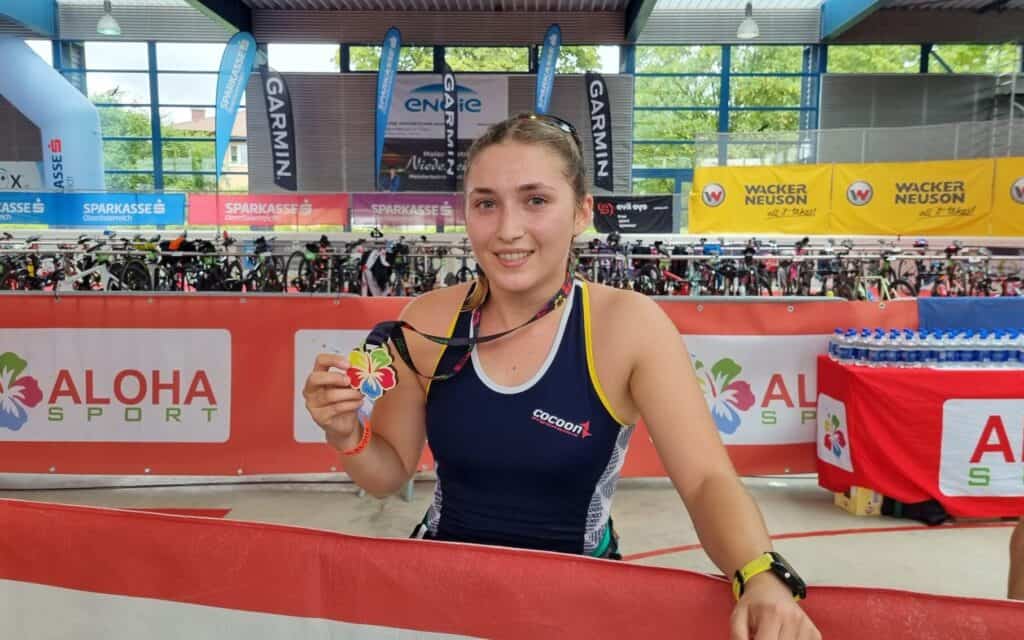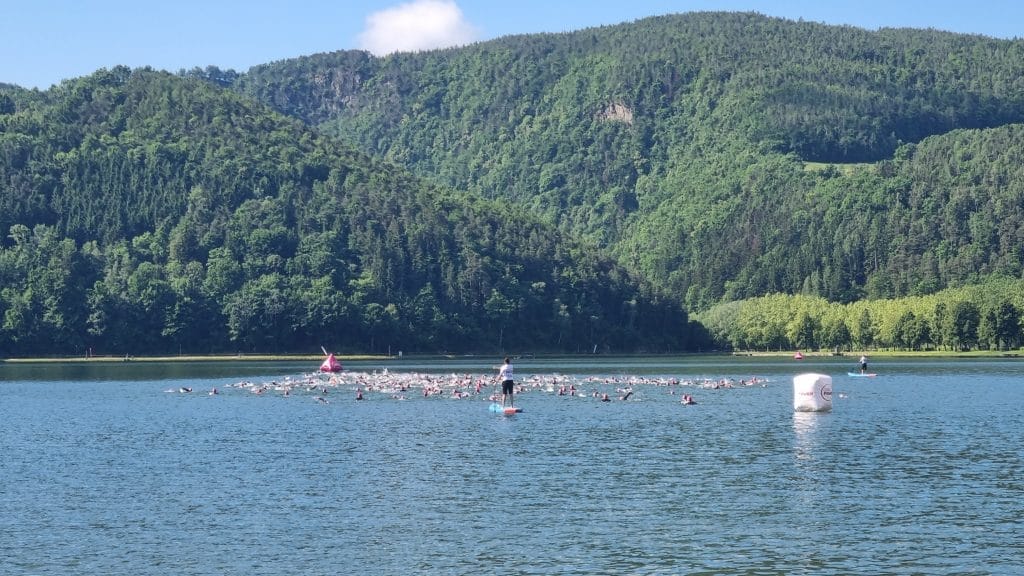How to Get Started with Triathlon (As a Complete Beginner)
You’ve heard about triathlon, maybe even watched a race, and now you’re wondering:
Could I do that?
The answer is YES!
Triathlon is one of the most rewarding and life-changing endurance sports.
It challenges you in ways you never imagined – physically, mentally, and emotionally.
But the thought of training for three sports at once can feel overwhelming, and let’s not even talk about the gear costs!
The good news?
You don’t need to be an elite athlete or spend a fortune to get started.
Whether your goal is to finish your first sprint triathlon or work toward an Ironman, this guide will teach you everything you need to know to start your journey correctly.
What Even Is a Triathlon?
A triathlon is a multisport race that combines swimming, cycling, and running in one event.
Athletes complete these three disciplines back-to-back with minimal rest in between.
Triathlon comes in different distances, so you can pick one that suits your current fitness level:
- Sprint Triathlon: 750m swim, 20km bike, 5km run (Best for beginners!)
- Olympic (Standard) Triathlon: 1.5km swim, 40km bike, 10km run
- Half-Ironman (70.3): 1.9km swim, 90km bike, 21.1km run
- Ironman: 3.8km swim, 180km bike, 42.2km run (Full marathon after 180km of cycling? Yes, really!)
For most beginners, a sprint triathlon is the best place to start – it’s challenging but achievable.
Why Do You Want to Start Triathlon?
Before you jump into training, take a moment to reflect on WHY you want to do this.
- Do you want to lose weight and get healthier?
- Are you looking for a new challenge or hobby?
- Do you love pushing yourself beyond your limits?
- Are you the type who enjoys doing things that scare you?
- …
Your motivation matters because it will keep you going when training gets tough.
It also determines how you train.
Someone aiming to complete one Ironman just to check it off their bucket list will approach training very differently from someone who wants to steadily improve and race triathlons for years.
Both are valid triathlon goals, but the safer and healthier approach is to build your endurance gradually rather than rush into an extreme challenge.
Get expert coaching, tailored to your schedule, so you can train smarter, race stronger, and still have time for life.
Step-by-Step Guide to Starting Triathlon
But now for the really exciting part, how to get started with triathlon! Here are the steps you might want to consider before you dive into triathlon training:
1. Pick a Goal Race

The best way to stay motivated is to sign up for a race (before you even start training).
This gives you a concrete deadline and keeps you accountable.
Look for a local sprint triathlon or a beginner-friendly race.
You might consider looking for a triathlon with a pool swim instead of an open water swim if you are not too comfortable in open water yet, or rather pick a flat bike course compared to a hilly course.
But that’s up to you.
Make sure that the race challenges you but doesn’t overwhelm you.
Lastly, check the race websites for cutoff times to ensure you have enough time to finish.
2. Get More Specific on Your Race Goals
Once you’ve picked your goal race, it’s time to get more specific about what success looks like for you.
Are you aiming to simply finish?
Do you want to hit a certain time?
Or is this just the beginning of a longer journey in triathlon?
Setting clear, realistic goals is key to staying motivated throughout training.
Here are some examples of beginner-friendly goals:
- “I just want to cross the finish line.” (Focus on endurance and building confidence in all three sports.)
- “I want to complete the race without stopping during any discipline.” (Work on pacing and smooth transitions.)
- “I want to finish under X time.” (Introduce structured training and track progress.)
- “I want to enjoy the experience and not feel overwhelmed.” (Prioritize consistency over intensity.)
Once you have a goal in mind, break it down further:
- What’s your biggest challenge (swimming, biking, running, or transitions)?
- How much time per week can you commit to training?
- What small milestones will help keep you on track?
Having a clear goal with measurable checkpoints makes it easier to stay focused and see your progress.
3. Get the Necessary Gear Without Overspending

Triathlon has a reputation for being an expensive sport, but you don’t need to buy top-of-the-line gear as a beginner.
Here is a short overview of the most important triathlon gear that will get you started.
Swim Gear:
- A comfortable swimsuit or a tri-suit
- A pair of well-fitting goggles
- A wetsuit if your race is in open water (This is optional, but for some cold races a wetsuit is mandatory!)
Bike Gear:
- Any bike you already own (road, hybrid, or mountain bike is fine)
- A helmet (mandatory in all races)
- A water bottle for hydration
Run Gear:
- A good pair of running shoes that suit your foot type
- Comfortable running clothes (if you’re not wearing a tri-suit)
That’s it!
You don’t need a fancy triathlon bike, aero helmet, or carbon fiber everything.
Borrow what you can, start simple, and upgrade later if you get hooked on the sport.
4. Work Out a Plan to Get to Your Goal

Once you’ve chosen your race, and have your specific goals set, it’s time to map out how you’ll get from where you are now to race day success.
Your starting point plays a huge role in how you should train.
Do you come from a running background, did you swim competitively as a kid or are you commuting to work by bike every day?
Or you haven’t done endurance sports before?
The starting point is very different for each person.
But your starting point is very relevant to know where to go from there.
If you’ve been running for some years before starting triathlon it’s better to dial down the running as it’s already a strength of yours and focus more on swimming or vice versa.
And if you’re not really experienced in any of the disciplines, work on all three equally.
5. Create a Realistic Training Plan
Once you have your plan on how to get from point A to point B, it’s time to start thinking about your training.
How Often Should You Train?
🏊♂️ Swim: 2–3 times per week
🚴 Bike: 2–3 times per week
🏃 Run: 2–3 times per week
🔄 Brick Workouts (Bike + Run): 1 time per week (as your race gets closer)
“Brick workouts” (where you practice running immediately after cycling) are key to avoiding the dreaded jelly legs on race day!
If your race includes open-water swimming, practice outside at least a few times.
Pool swimming doesn’t fully prepare you for the challenges of waves, sighting, and group swimming.
Get expert coaching, tailored to your schedule, so you can train smarter, race stronger, and still have time for life.
6. Do the work

Now comes the most important part – putting in the training.
You don’t need to train like a professional triathlete, but consistency is key.
- Follow the training plan you created. If you miss a session, don’t stress – just get back on track.
- Track your workouts. Use a training app or keep a simple log of distances, times, and how you felt.
- Listen to your body. If you’re feeling overly fatigued, adjust your plan instead of pushing through potential injury.
- Practice race-day conditions. This means doing open-water swims if your race includes one, trying out your triathlon outfit in training, and doing a few “mini-triathlon” workouts to get used to the flow of transitions.
The hardest part is often just showing up and staying consistent.
Every training session builds confidence, endurance, and skill.
7. Stay Motivated and Build Consistency
Starting triathlon is easy – sticking with it is harder. The real key to endurance sports is consistency over time.
Here’s how to stay motivated:
- Track your progress: log your workouts and celebrate small wins
- Train with a buddy or club: it’s more fun and keeps you accountable
- Mix up your training: explore different routes, join group rides, or try a new swimming drill
- Remember your “why”: on tough days, remind yourself why you started
8. Race Day Tips for Your First Triathlon

Here are a few tips for your first race.
- Arrive early: set up your gear in the transition area calmly
- Lay out your gear neatly: place your helmet, shoes, and nutrition in an easy-to-access spot
- Start slow: don’t go all-out in the swim; pacing is key
- Practice your transitions: fast transitions save time, but keep them simple
- Enjoy the experience! Your first triathlon should be fun, not stressful.
These are only a few of the most important tips…
This article is all about race day tips, so make sure to check this one out as well!
Taking It to the Next Level
So, you’ve finished your first triathlon – what now?
Some beginners complete their first race and decide that’s enough, while others catch the “triathlon bug” and start thinking about the next challenge.
Here’s how you can level up:
- Improve your weak discipline: if swimming was tough, work on your technique
- Train smarter, not harder: follow structured training plans
- Upgrade your gear when needed: consider clipless pedals, a wetsuit, or a tri-bike
- Tackle a new distance: maybe an Olympic triathlon is next?
The beauty of triathlon is that there’s always another challenge ahead.
Whether you want to go longer, get faster, or simply enjoy the sport more, the possibilities are endless.
Wrapping Up
Triathlon may seem intimidating, but it’s more accessible than you think.
By choosing a beginner-friendly race, training consistently, and keeping things simple, you’ll be ready to cross that finish line – and who knows, maybe fall in love with the sport!
So what’s stopping you?
Pick your first race, start training, and get ready for an adventure that will challenge and change you in ways you never expected.
🏊♂️🚴🏃♂️ See you at the start line!
Read More About Starting with Triathlon
- Triathlon Terminology: 120+ Terms Triathletes Need to Know
- 16 Incredible Triathlon Benefits: Why You Should Start Today
- Triathlon History: From California to the Olympic Games
- The Ultimate Guide: How Long to Train for Triathlon Triumph
- What Order is a Triathlon and WHY??
- Triathlon VS Ironman: But What’s The Difference??
- How Long Does a Triathlon Take for Elite vs. Amateurs?
- How to Choose a Triathlon: A Step-by-Step Guide
- How to Set Triathlon Goals and Crush Your Next Race
- Mistakes To Avoid While Training For Your First Triathlon
- 50 Triathlon Essentials ALL Beginner Triathletes Need
- 16 Powerful Cycling Tips for Triathletes
- 25 Essential Race Day Tips for Triathletes
- Feeling Lost? This is What to Wear for a Sprint Triathlon!
- The Importance Of Mental Training For Athletes In 2024
- 15 Triathlon Transition Tips That Make You A Better Triathlete
- 4 Brick Workouts For Triathlon Success
- Strength Training For Triathletes + The 10 Best Exercises
